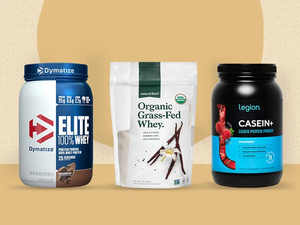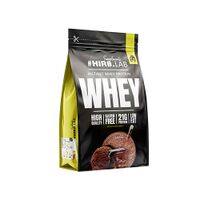Course:FNH200/Projects/2023/Protein Powder

Introduction
Proteins are complex molecules composed of large chains of amino acids that serve a multitude of vital functions in the human body. [1] To support muscle repair and maintain a positive muscle protein balance, 1.4-2.0 g/kg/d is recommended for the majority of the exercising population.[2] Protein supplementation has been established to augment increases in muscle mass and strength when accompanied with resistance exercise.[3] Many individuals aiming to build muscle mass often struggle to consume an adequate amount of protein from whole foods alone, due to a variety of factors such as cost, convenience, and caloric restrictions. [2] Though protein powders first appeared in the 1950's,[4] they have significantly increased in popularity over the past decade due to an array of confounding variables such as increased consumer desire for convenience and expansion of the health supplement industry largely as a result of a wider target audience.
Types of Protein Powder
Various types of protein powders exist on the market today, each with its own unique characteristics, sources, and benefits. The most prominent types in the realm of food science and nutrition today are whey, casein and plant-based protein.

Whey Protein
Whey protein is the most common type of protein supplement, derived from the liquid by-product of milk during cheese production.[5] Whey is rich in branched-chain amino acids (BCAAs), specifically leucine, and is absorbed quickly by the human body, thus making it beneficial for muscle protein synthesis and recovery. [6] There are several commercial whey protein subtypes categorized by protein composition and production:
- Concentrate: This form is typically composed of 70-80% protein, along with minimal amounts of fats and carbohydrates.[7]
- Isolate: This form undergoes further processing to remove fats and carbohydrates, thus resulting in a higher protein content of ≥ 90%.[8]
- Hydrolysate: This type of whey protein is pre-digested, which results in the lowest lactose content and faster rate of digestion and absorption. [9]
Casein Protein
Casein is also a milk-derived protein,[10] but it differs from whey protein in terms of digestion and absorption rate. Casein is digested and absorbed by the body at a much slower speed due to its gel-like formation upon reacting with stomach acid, resulting in a sustained release of amino acids over a longer period of time without a large spike in muscle protein synthesis.[11]
Plant-based Protein
Plant-based protein powders are typically derived from various types of plants, such as soy, pea, brown rice, and hemp. Since they are produce entirely from plants, they do not contain any dairy or lactose, thus making it a suitable protein supplement for lactose intolerant individuals or for those following a vegan diet.[12] The amino acid profile of plant-based protein powders vary depending on the plant it is derived from. While they typically contain fewer BCAAs than whey powders, soy protein powder contains all the essential amino acids,[13] thus making it an excellent alternative for those with dietary restrictions.
Processing and Preservation
Different types of protein powder are processed in different ways in order to isolate their protein components, though their processes often utilize similar methods. In all cases, the principle of dehydration provides protein powders with a long shelf life, as well as convenience of transport, storage, and consumption. The processing of various types of protein powders is detailed below.
Whey Protein
Whey protein powder is derived from a byproduct of cheese production, whey. When milk is coagulated, whey is left over as a liquid. The liquid whey is sent to a protein processing plant where ceramic filters separate fats and lactose from the liquid solution, eventually producing whey protein liquid.[14] In order to produce protein powders with higher protein concentrations, the liquid undergoes further microfiltering. The filtered liquid is then dehydrated, often using the method of spray drying, which works well with large quantities of liquid.[14] After dehydration, only whey protein powder remains, which is then tested for purity and blended with flavours. The final product is packaged and shipped to stores and consumers for consumption.[14] Since the protein powder is dehydrated, microbial growth as well as chemical and enzymatic reactions are halted. Its lack of free water provides it with a shelf life of over twelve months when properly stored.[3]
Casein Protein
Casein, similarly to whey, is also a byproduct of cheese production. The process to create casein protein powder is similar to that of whey. Typically, skim milk is treated with rennet to produce rennet casein, which is then separated, washed, and dried.[15] More recently, advancements in microfiltration technology allows micellar caseins to be obtained from skim milk, which offers greater nutritional value.[16] Then, the casein is spray dried, similarly to whey, leaving casein protein powder. Finally, the powder can again be flavoured and tested as required, then packaged and shipped.[3]
Plant-based Protein
The exact method of processing plant-based proteins depends on the type of plant the protein is derived from, but the overall process remains similar between plants. For example, in pea-based protein powders, the pea's outer shell is removed and milled into a flour, while the fibre and starch from the pea are separated through filtration.[17] Next, these separated parts are distilled into a precipitate, which is finally separated out in a centrifuge, leaving only plant protein powder.[17] Other plants such as soy or brown rice are similarly first milled into a flour, then filtered to extract the protein component of the plant.[18]
Packaging and Storage

The packaging of protein powder plays a vital role in ensuring the preservation of the product’s quality. Maintaining the integrity of protein powder demands robust defence against external factors including oxygen, moisture and light.[19] Generally, unopened protein powder stored in a cool, dry, and dark environment can retain its quality for approximately 1 to 2 years beyond the date of manufacture, signs of protein powder degradation include changes in colour, texture, or aroma. [19] When stored in an environment with a high relative humidity, caking is promoted, resulting in undesirable texture and quality degradation.[20] Employing modified atmospheric packaging (MAP) such as nitrogen flushing, allows for nitrogen to remove oxygen within the packaging.[21] This process retards oxidation, preventing spoilage and effectively extending the protein powder’s shelf life.[21] A common packaging option is multi-walled 3-4 ply Kraft paper bags, lined with 3-4 mm thick low-density polyethylene (LDPE).[21] LDPE bags are effective packaging solutions due to their low permeability to moisture and gasses. As such, they function as effective moisture barriers, shielding the product from moisture which can lead to undesirable clumping and degradation of quality.[22]
Maillard reactions persist post-processing, accelerated by heat and humidity such that protein powder stored in a hot environment with sunlight exposure may undergo alterations in colour, aroma and flavour profile.[23] Furthermore, Maillard reactions increase when the water activity falls within the range of 0.5 to 0.8.[24] [25] The exposure of protein powder to humidity accelerates browning by acting as a medium for water molecules to interact with the amino acids and reducing sugars, promoting chemical reactions.[26]
Potential Exam Question
What storage environment would cause the most caking of protein powder?
a) High Temperature + High relative humidity
b) High Temperature + Low relative humidity
c) Low Temperature + Low relative humidity
d) None; significant caking would not occur in any of the above conditions
Why is this Important?
As protein powders continue to gain popularity, protein powders are likely present in many students' households. Proper storage ensures that the powder retains quality, taste, colour, and texture over time. It is also important to note which conditions caking may occur in as it is common for caking to occur in transit. If the product is being transported in a hot environment with high relative humidity, caking may occur before it has even been opened by the consumer. While this is an unfortunate occurrence as the texture of the powder may be diminished, it is important to know that the product is still safe to consume and does not need to be thrown out. This question should be considered as an addition for the final exam because of its practical application. As a wide variety of health supplement powders clump under high temperature + high relative humidity conditions, it should provide students reassurance that despite clumping, their powder products are still safe to consume.
References
- ↑ "What are proteins and what do they do?". MedlinePlus. Retrieved July 31, 2023.
- ↑ 2.0 2.1 Jager; et al. (2017). "International Society of Sports Nutrition Position Stand: protein and exercise". Journal of the International Society of Sports Nutrition – via Taylor & Francis Online. Explicit use of et al. in:
|last2=(help) - ↑ 3.0 3.1 3.2 Van de Walle, Gavin. "Does Protein Powder Expire?".
- ↑ "Bodybuilding Supplement". Wikipedia. Retrieved July 31, 2023.
- ↑ Spritzler, Franziska; Ajmera, Rachael. "The 7 Best Types of Protein Powder".
- ↑ Matsui; et al. (2019). "Effect of a leucine-enriched essential amino acids mixture on muscle recovery". Journal of Physical Therapy Science. Explicit use of et al. in:
|first=(help) - ↑ Gunnars, Kris. "Whey Protein 101: The Ultimate Beginner's Guide".
- ↑ Cox, Lauren (2014). "What Is Whey Protein?". Live Science.
- ↑ Foegeding, E. A.; Davis, J. P.; Doucet, D.; McGuffey, M. K. (2002). "Advances in modifying and understanding whey protein functionality". Trends in Food Science & Technology. 13 (5): 151–159. doi:10.1016/S0924-2244(02)00111-5.
- ↑ Van De Walle, Gavin (2023). "What's the Difference Between Casein and Whey Protein?".
- ↑ Boirie; et al. (1997). "Slow and fast dietary proteins differently modulate postprandial protein accretion". Proceedings of the National Academy of Sciences. 94(26): 14930–14935. doi:10.1073/pnas.94.26.14930. Explicit use of et al. in:
|last=(help) - ↑ Davidson, K. (2021). "Plant-Based Protein vs. Whey Protein: Which Is Better?". Healthline.
- ↑ Gorissen; et al. (2018). "Protein content and amino acid composition of commercially available plant-based protein isolates". Amino Acids. 50(12): 1685–1695. doi:10.1007/s00726-018-2640-5. Explicit use of et al. in:
|last=(help) - ↑ 14.0 14.1 14.2 Gray, Gareth. "How Whey Protein Is Made | Step-By-Step".
- ↑ Sarode, A.R.; et al. "Casein and Caseinate: Methods of Manufacture". Encyclopedia of Food and Health: 676–682. Explicit use of et al. in:
|first2=(help);|first2=missing|last2=(help) - ↑ Carter, B.G.; et al. "Invited review: Microfiltration-derived casein and whey proteins from milk". Journal of Dairy Science: 2465–2479. Explicit use of et al. in:
|last2=(help) - ↑ 17.0 17.1 Wilcock, Emily. "How Vegan Protein Powder Is Made | In The Lab".
- ↑ Cudmore, Dale. "How Is Vegan Protein Powder Made?".
- ↑ 19.0 19.1 "How Long Does Protein Powder Last?".
- ↑ Ozel; et al. "Challenges in dried whey powder production: Quality problems". Food Research International – via Elsevier. Explicit use of et al. in:
|first=(help) - ↑ 21.0 21.1 21.2 "How Nitrogen Gas Benefits the Food Packaging Industry".
- ↑ "Types of Plastic Food Packaging".
- ↑ "Shelf-life of food powders". Handbook of Food Powders. doi:10.1533/9780857098672.2.409.
- ↑ "Effect of Maillard reaction conditions on the degree of glycation and functional properties of whey protein isolate – Maltodextrin conjugates". Food Hydrocolloids.
- ↑ "Milk Powders Ageing: Effect on Physical and Functional Properties". Critical Review in Food Science and Nutrition.
- ↑ Whey Proteins from Milk to Medicine. doi:https://doi.org/10.1016/B978-0-12-812124-5.00004-7 Check
|doi=value (help).